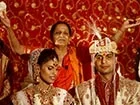Got this by email:
EQUALITY OF MEN AND WOMEN IN SANATANA DHARMA.
As per Vedanta, man and woman are two aspects of the same divinity.
(See ShwEtAswatara Upanishat 4.3., Brihadaaranyaka Upanishat 1.4.3.)
That there was equal opportunity for both of them is established with the examples of MaitrEyi, and Vaagaabhrni (see BU 2.4.3-5., and RV 10.125).
The Brahmavidya of Vaagaambrni, the intellectualism of Gaargi vaachaknavi, the yogic mysticism of of Suabhaa, the scholarship of Arundhati etc., are all well documented.
(see RV 10.125.1-8., BU 3.6.1., Mahabhararatha Shantiparva 320., MB anushaasanaparva 130 etc.,)
More than thirty women sages (like Vishvavara, Apaala, Ghosha Kaksheevati etc.,)are mentioned in Rigveda itself
Upanayana for girls which was in existence during Vedic times had vanished by the time of Manu. (around 200BC).
Why only men and women, even every creature in the world are the Atman which is immortal, pure consciousness.
Jeeva is sometimes born in a male body and sometimes as a female.
This was known to our ancestors and so, there was equal opportunity for both men and women.
Social upheavals and frequent foreign invasions contributed to the gradual decline in their status.
Child marriages and the problems of young widows cropped up as a result.
Though divorces were unknown, remarriage of women was permitted when husband died before consummation or when he was missing for a long time or when he took sanyas.
( as in the case of Damayanti and Nala).
WIDOW MARRIAGE AND SANATANA DHARMA.
Marriage is an important sacrament in sanatana dharma. A person enters householder's status only after this samskaara. One cannot perform any of the religious rites without the marriage.Taittareeya Brahmana says, äyajniyO vA yEshayO apatneekaha". (T.B. 2.2.2.6.)
Although marriage provides daampatya sukha to the individuals, there is an element of utility to the families, the society and the nation at large.
What is the status of a wife?
"aThO ardhO vA yEsha Atmanaha yatapatnee"(T.B. 2.9.4.7.)
This means that the husband and wife have the same status.
The husband when he brings his wife to his home for the first time utters, "asmin grihE gaahapthyaaya jaagrihee". (R. V. mandala 10, sukta85, mantra27.).
It means, "be the head of this home".
Some people think that Manu was an enemy of the women.
"ÿathyvaatmaa thathaa putraha, putrEna duhitaa samaa " says Manusmriti.
That means there is no difference between a son and a daughter.
When such is the shaastra, why this discrimination between a man and a woman?
This practice is thus against the dharma.
It is an artificially created aberration.
The discrimination is most predominant in the way widows are treated in our society.
The various attachments that a girl gets from her birth itself like kumkum, haldi, bangles, flowers etc., are taken out forcibly in an inhuman way from her once her husband dies.
Till recently there was a practice of removing her hair thus reducing her to an intolerable situation.
Even now, there are few such cases going on in certain pockets.
But the same set of rules are not applied to the man who marries giving an oath,
"dharmEcha arthEcha kAmEcha naathi charaami"".
where is the statement that "putrEna duhitaa samaa"?
Is this not against the dharmasastra?
The woman who is condemned from her birth itself that she is weak, after such a treatment from her own relatives and the society becomes totally condemned and gets relegated to a corner.
We may still see such a situation in the remote villages although this may not be the case in bigger cities.
The man who loses his wife almost immediately takes another wife.
The second wife gets an additional responsibility of looking after the children from his first marriage also.
Would a lady get a similar facility?
What do the dharmashaastras, the vedas, upanishats and other texts on sanatana dharma say about this?
Rigveda (10.40.5.) says,
kuhasviddOshA kuhavastOrashvinA kuhAbhishittvam karatah kuhOshatuhu.
kO vAm shayutrA vidhavEda dEvara maryam na yOshA krNitE saadastha Aa.
As per SayaNa bhaashya a widow can take another husband after her husband's death.
The man who marries a widow is not considered inferior to other men.
Widow marriage is not forbidden.
The first mantra of the third sookta of the fourteenth kaanda of Atharva Veda lays down that a woman whose husband dies, should accept another person who can provide food, clothes and shelter and can also give good children.
Manusmriti also provides a few slokas giving the same view.
"yaa patyaavaa parityaktaa vidhavaa vaa svayEchchayaa,
utpaadayEta punarbhootvaa sa sounarbhava uchyatE,
saa chEdakshata yOsaaha syaata gata pattyaagataapi vaa,
pounrbhavEna bhartyaa saa punaha samskaaramarhati."
It means, if the lady is either rejected by her husband or if he is dead, she should marry again.
Kaatyaayana smriti says, "varayitaa tu yah kaschit praNashyEt purushOyadaa.
rutvaagamaam streenateetya kanyaanyam varayEdvaram."
That means the widow should marry three months after her husband's death.
Prajaapati smriti also provides for the remarriage of young widows or for those ladies who are rejected by their husbands.
"yadisaa baalavidhavaa balaata tyaktaathavaa kvachit".
Mahabharata mentions that even when there is a doubt about the existence of the husband, his wife can remarry.
"Aasthhaasyati punarbhymee damayantee svayamvaram,
tatra gachchanti raajaanO raajaputraascha sarvashaha."
-mahabharatha, vanaparva,ch.70, shloka24.
more clearly,
"sooryOdayE dviteeyam saabhartaaram varayishyati,
na hi sa jnaanayitE veerO nalO jeevati vaa na raa".
-mahabharata vanaparva, ch.70. sloka 26.
( Damayanti is going to marry the next morning. The doubt about the powerful Nala's existence is the reason for this decision.).
One can find similar views in Bheeshma parva chapters 90 and 91 also.
A princess who is widowed 20 times marries 21 times as mentioned in Padmapuraana.
Although because of the efforts of the great social reformers like Eshvar chandra vidyasagar, Dr. Tejbhahadur saproo and others, it has been accepted legally,
the practice is yet take roots in India.
The problem is peculiarly special perhaps in India alone and especially in the Sanatanadharma followers

